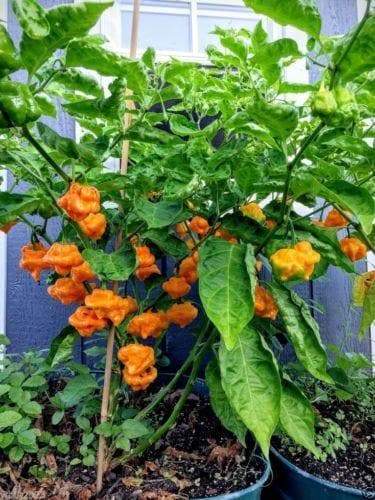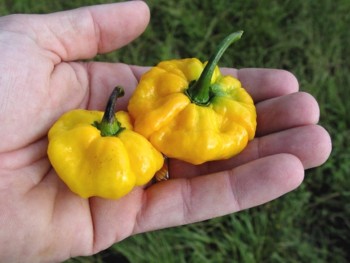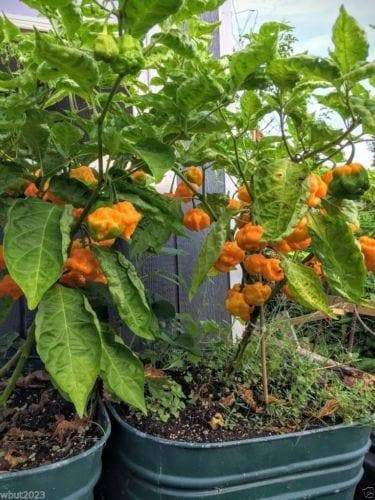
JAMAICAN YELLOW SCOTCH BONNET PEPPER Seeds,Capsicum chinense
Most orders are processed by the next day
Select your desired size and/or color from the available options.
Scotch Bonnet Jamaica Yellow PepperChili,Heirloom,(Capsicum chinense)
(Capsicum chinense) The famous Jamaican Scotch Bonnet bears squash-like peppers with an extremely hot flavor, rivaling that of many Habanero's. Fruits have a good, fruity flavor and an interesting combination of sweet and spice that make them popular for hot sauces and eating fresh. Compact, well-yielding plants. 95 days
Please Use Drop Down Box to Order.
- 10 Seeds
- 50 Seeds
- 100 Seeds
- 1,000 Seeds
Jamaica is almost as famous for its fiery Scotch bonnet peppers (which are rated as hotter than most habaneros) as it is for Reggae music and sports. Rarely will you find a Jamaican cooking without some of this pepper. Most often used on jerk chicken or pork, peppered shrimp, peppered steak and patties (a meat-filled pie), Scotch bonnet is the pepper of choice among Caribbean nationals. But for most visitors, especially those unfamiliar with this pungent chile, the strength of the Scotch bonnet is a shock.
The Scotch bonnet’s history has been traced to Central and South America; however, there is no concrete proof as to where the chile pepper was first cultivated. Although frequently confused with the habanero, the Scotch bonnet or Jamaican Hot is definitely not the same as its stout cousin. So how do you know a Scotch bonnet pepper? The mature pepper measures between 1 1/2 and 2 inches in diameter. The color of the immature pepper is green, but the mature Scotch bonnet has an attractive range of colors: bright yellow, orange or red. One of the defining features of this type of pepper is its sweet aroma and unique flavor. In fact, the Scotch bonnet was the first Caribbean hot pepper to be known by a specific name in the export market.
As you can see at left, as early as 1767 the chile was named “Bonnet or Goat Pepper,” the name “goat” resulting from its unique aroma, which was said to resemble “the odour of the he-goat.” The other peppers illustrated are fat pork pepper, bird pepper, cherry pepper, and Negro pepper.
The heat rating of the Scotch bonnet is said to be in the range of 150,000 to 325,000 Scoville Heat Units. Now that’s hot!
The Scotch bonnet pepper (Capsicum chinense Jacq.) is one of Jamaica’s major agricultural exports. The pepper strives in almost any of the country’s fourteen parishes, because of the tropical climate in which the plant grows best. However, the country’s producers are rarely able to meet the high demand for the product locally or internationally. Jamaican Scotch bonnet pepper is normally sold fresh, but there are also many by-products available such as jerk sauce, mash (both wet and dry) and escoveitch sauce.
Green Thumb Tip
Sow seeds indoors ¼" deep. Peppers germinate best in warm soil, so gentle bottom heat may be helpful until seedlings emerge. Wait to transplant outdoors until soil is warm.
Growing Peppers:
Peppers, like tomatoes, grow in well-drained fertile soil
Almost all peppers have the same requirements for successful growth. Plant them in good, well-drained, fertile soil – and make sure they get lots of sunlight and a good inch of water per week. In many ways, they mimic the same requirements needed for growing great tomatoes.
At Planting Time:
We plant all of our peppers with a good shovel full of compost in the planting hole, and then give them a good dose of compost tea every few weeks for the first 6 weeks of growth. We also mulch around each of our pepper plants with a good 1 to 2″ thick layer of compost
Peppers often like to take their sweet time germinating. They can be up in a week, and some will take almost a month. Even with paper towel germination testing, they can take long. I am not sure why, but it is a normal occurrence. So plan and make sure you start them early enough! Also, remember they like heat to germinate so make sure you have a heating mat or something to keep the soil warm. Placing them up on top of the fridge often works too since it is normally warmer up there.
Peppers do very well grown in pots.
LET OUR CUSTOMER SPEAK FOR US

![[Seeds] - Caribbeangardenseed](http://caribbeangardenseed.com/cdn/shop/files/gift-card-gift-card-1_1024x1024_dfa857db-9150-4315-a362-7f0bb3fb9c47_60x28.png?v=1703978838)
